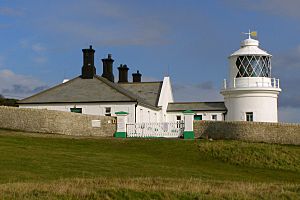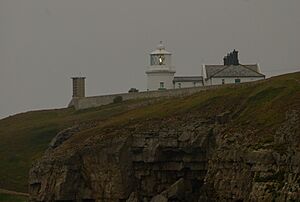Anvil Point Lighthouse facts for kids
| Location | Swanage Dorset England |
|---|---|
| Coordinates | 50°35′30.8″N 1°57′35.3″W / 50.591889°N 1.959806°W |
| Year first constructed | 1881 |
| Automated | 1991 |
| Construction | stone tower |
| Tower shape | cylindrical tower with balcony and lantern |
| Markings / pattern | white tower and lantern |
| Height | 12 m (39 ft) |
| Focal height | 45 m (148 ft) |
| Original lens | 250mm 6 panel fourth order rotating optic (original), 1 single tier LED lantern (current) |
| Intensity | 1,080 candela |
| Range | 9 nmi (17 km; 10 mi) |
| Characteristic | Fl W 10s. |
| Fog signal | deactivated |
The Anvil Point Lighthouse is a cool, automated lighthouse found in Durlston Country Park. It's near Swanage in Dorset, England. This lighthouse belongs to Trinity House, which is a special group that looks after lighthouses. Today, parts of the lighthouse are even used as two holiday cottages]!
The lighthouse building, along with its living areas and other connected structures, is a special Grade II listed building. This means it's an important historical site.
Contents
History of Anvil Point Lighthouse
The Anvil Point Lighthouse was built using local stone. It was finished in 1881. A person named Joseph Chamberlain, who was in charge of the Board of Trade at the time, officially opened it.
The lighthouse tower stands about 12 m (39 ft) (about 39 feet) tall. The light itself is positioned 45 m (148 ft) (about 148 feet) above the high-water mark. Its main job is to guide ships safely as they travel along the English Channel coast.
Early Lighting Technology
When it first started, the lighthouse used a special mineral oil lamp. This lamp had many wicks and was designed by James Douglass. The light shone through a very large, rotating lens system. This lens was called a Fresnel lens, and it was a new design for its time.
This special lens was about 6 ft 2 in (1.88 m) (about 1.88 meters) tall. It was made in a way that allowed it to be much taller than older lenses. This meant it didn't need extra mirrors to help spread the light.
Fog Signals and Upgrades
In February 1894, an explosive fog signal was added to the lighthouse. This signal would make a loud sound every ten minutes when it was foggy. Later, this was changed to every five minutes.
In the early 1900s, the oil lamp was replaced with a newer type of lamp. This new lamp used paraffin vapour, which was a more modern fuel.
The lighthouse got a big upgrade in 1960. It was connected to electricity, and a new electric lamp replaced the old paraffin one. The original large lens was also removed and given to the Science Museum.
At the same time, the explosive fog signal was replaced. A new electric signal was installed, which used a stack of thirty speakers. This new signal would sound from the seaward side of the lighthouse.
Automation and Modern Light
In 1981, new automatic equipment was put in place. The fog signal, however, was stopped in 1988.
The Anvil Point Lighthouse became fully automated on May 31, 1991. This means it no longer needed people to operate it all the time. Now, it is watched and controlled from the Trinity House Operations Control Centre in Harwich.
The lighthouse used to have a very powerful light, shining with an intensity of 500,000 Candela. Its light could be seen from about 19 nautical miles (35 km; 22 mi) (about 35 kilometers) away. However, after a review in 2010, its range was reduced to 9 nautical miles (17 km; 10 mi) (about 16.7 kilometers).
In 2012, a modern LED lamp was installed. This LED lamp now serves as the main light at Anvil Point. It still flashes white every 10 seconds, just like before. The old rotating lens is still inside the tower, even though it's not used anymore.
See also
- List of lighthouses in England



